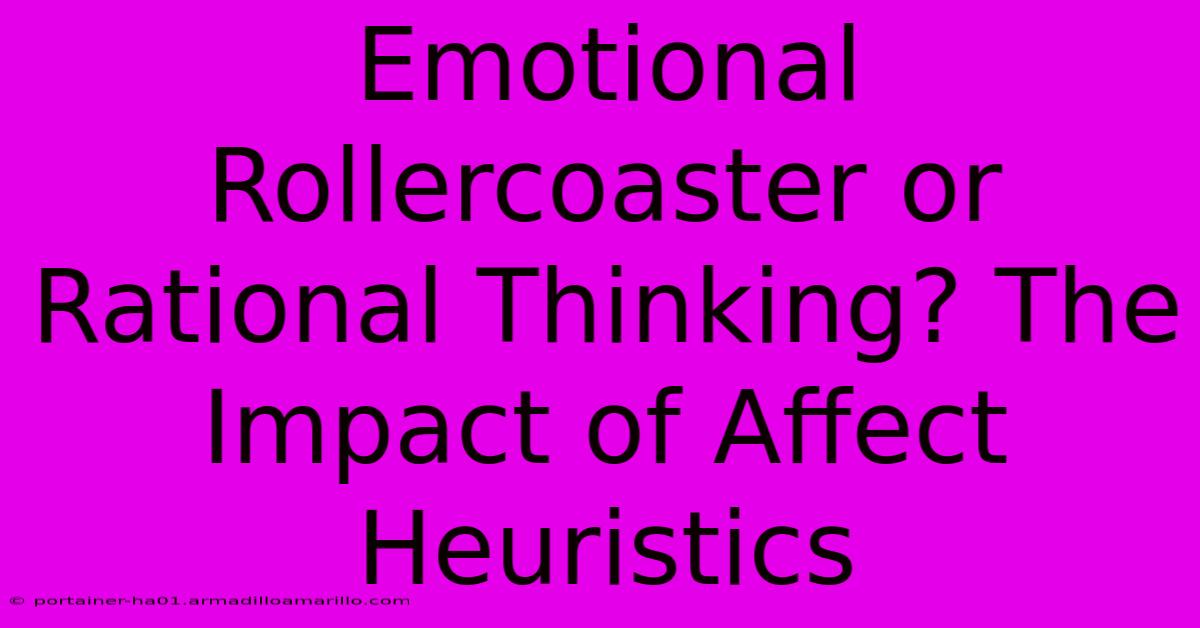Emotional Rollercoaster Or Rational Thinking? The Impact Of Affect Heuristics

Table of Contents
Emotional Rollercoaster or Rational Thinking? The Impact of Affect Heuristics
We pride ourselves on being rational beings, carefully weighing options and making decisions based on logic and reason. But what if I told you that a significant portion of our choices are driven by something far less cerebral: our emotions? This is where affect heuristics come into play, subtly shaping our judgments and decisions in ways we may not even realize. Understanding affect heuristics is crucial to navigating the complexities of human behavior and making more informed choices.
What are Affect Heuristics?
Affect heuristics represent a mental shortcut where we rely on our immediate emotional responses – our "gut feelings" – to make judgments. Instead of meticulously analyzing data and weighing pros and cons, we base our decisions on how a particular option makes us feel. This "feeling" acts as a heuristic, a mental rule of thumb, guiding us towards choices that evoke positive emotions and away from those that trigger negative ones.
Think about it: Would you rather invest in a company that evokes a sense of excitement and opportunity, or one that leaves you feeling apprehensive and uncertain? Most people will lean towards the former, even if the latter might offer a more objectively sound investment. This is the power of affect heuristics at work.
The Role of Emotions in Decision-Making
Emotions aren't simply irrational intruders in the decision-making process; they're deeply integrated into our cognitive architecture. Our feelings provide rapid, intuitive assessments of situations, often serving as valuable (albeit sometimes misleading) guides. While this can be incredibly efficient, relying solely on affect heuristics can lead to biases and suboptimal choices.
Examples of Affect Heuristics in Action
Affect heuristics manifest in numerous ways throughout our daily lives:
- Product Marketing: Advertisements often leverage affect heuristics by associating their products with positive emotions like joy, excitement, or security. A happy family enjoying a car ride sells more cars than a chart showing MPG.
- Political Campaigns: Candidates often cultivate specific emotional connections with voters, hoping to evoke feelings of trust, hope, or patriotism, rather than relying solely on policy details.
- Risk Perception: We tend to overestimate the risk of events that evoke strong negative emotions (like shark attacks), while underestimating the risk of more mundane but statistically significant threats (like car accidents).
- Environmental Issues: Appeals to protect endangered species often rely on evoking emotional responses towards cute animals, rather than purely on scientific data regarding biodiversity.
The Downsides of Letting Emotions Take the Wheel
While affect heuristics can be efficient, over-reliance on them can lead to significant problems:
- Biased Judgments: Emotions can distort our perception of reality, leading to inaccurate assessments and poor decisions.
- Irrational Choices: We might choose options that feel good in the short term but have negative long-term consequences.
- Vulnerability to Manipulation: Marketers and others can exploit our emotional vulnerabilities to influence our choices.
Striking a Balance: Rationality and Emotion
The key isn't to eliminate emotions from decision-making – that's unrealistic and even undesirable. Instead, the goal is to cultivate a more balanced approach, integrating both rational analysis and emotional awareness. Here are some strategies:
- Emotional Awareness: Pay attention to your emotions and identify the triggers that lead to impulsive decisions.
- Fact-Checking: Once you've identified an initial emotional response, take a step back and examine the facts objectively.
- Seeking Diverse Perspectives: Discuss your decision with others to gain different viewpoints and challenge your biases.
- Delayed Gratification: Postpone making a decision when emotions are running high, giving yourself time to cool down and think clearly.
Conclusion: Navigating the Emotional Landscape
Affect heuristics are a powerful force shaping our choices. By understanding how emotions influence our judgments, we can improve our ability to make more informed, rational decisions. The path to better choices lies not in suppressing emotions but in recognizing their role and consciously working towards a balance between emotional intuition and rational analysis. This journey of self-awareness is essential for navigating the complex emotional landscape of decision-making.

Thank you for visiting our website wich cover about Emotional Rollercoaster Or Rational Thinking? The Impact Of Affect Heuristics. We hope the information provided has been useful to you. Feel free to contact us if you have any questions or need further assistance. See you next time and dont miss to bookmark.
Featured Posts
-
Landscaping Business Cards That Will Make Your Business Stand Out
Feb 07, 2025
-
Unveil The Hidden Meaning The Enigma Of The Black American Flag With Red Stripe
Feb 07, 2025
-
The Gas Ses Of Life Unveiling The Essential Role Of Gases And Gasses In Our Universe
Feb 07, 2025
-
Inside Superside Unveiling The Legitimacy Of The Design Powerhouse
Feb 07, 2025
-
Overcoming The Endowment Effect When Less Is More
Feb 07, 2025
